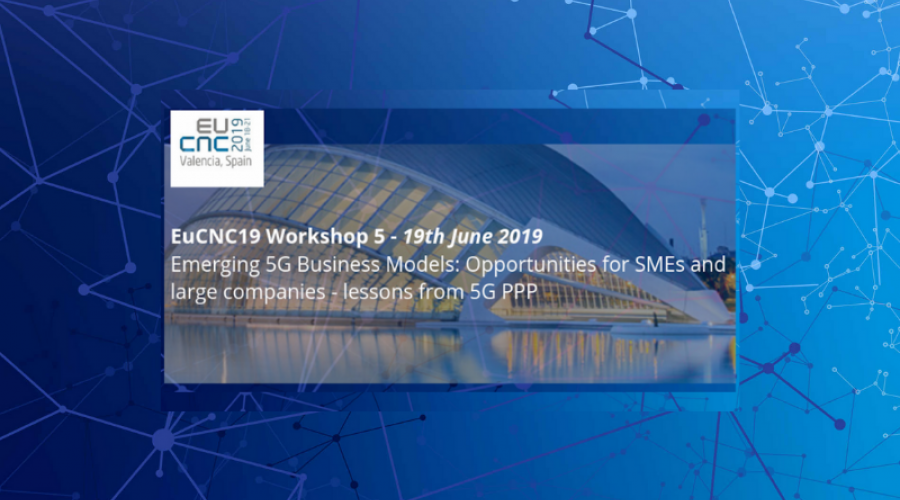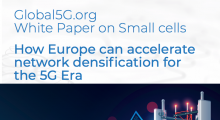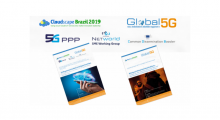Report on EuCNC 2019 Business Models Workshop

The organisation of the workshop was a joint initiative by the two Coordination and Support Actions of the 5G Public-Private Partnership: To-Euro5G and Global5G.org with the support of the NetWorld2020 SME Working Group. In addition, they were assisted in the organisation by the EC Common Dissemination Booster, whose mission is exactly to support this type of joint dissemination of research and innovation actions with a view to exploiting results.
Why have a workshop on “emerging business models” and why talk about Small-to-Medium Enterprises (SMEs) in this context? Because first of all, there is widespread belief that the imminent arrival of 5G will bring disruption in business models for incumbent operators and verticals alike. But secondly, while opportunities will surely arise for large, well-positioned market participants, the real winners may well be those SMEs who have mastered the key technologies and services enabling the new business models emerging from the inevitable disruption not only in the telecommunications ecosystem but also in the vertical sectors making use of 5G including automotive, manufacturing, health, energy, and others. With this workshop, we wanted to test that hypothesis – we wanted to find out what kind of business models really were poised to emerge from the inevitable disruption of 5G, and what opportunities this disruption was really bringing for SMEs.
As a featured workshop by the 5G PPP during EuCNC, it gathered a full room of participants, coming from enterprises large and small, public and private, including EC representatives. The workshop was organised by Jacques Magen, Interinnov and chair of the SME WG, and Stephanie Parker, Trust-IT and Coordinator of Global5G.org. It was co-chaired by John Favaro of Trust-IT, who is the Deputy Director of Global5G.org, and Nicola Ciulli, Head of R&D at Nextworks, a leading SME in 5G technologies, and also Co-Chair of the SME WG.
Co-Chair Nicola kicked off the workshop with a brief overview of the complex environment faced by SMEs, giving the participants much to keep in mind as they listened to the presentations.
Then Co-Chair John stepped in and opened the first session of the day, with the purpose of “getting the creative juices flowing” and stimulating ideas among the participants. First up was Darko Ratkaj from the European Broadcasting Union (EBU), who presented on the enormous disruption in the services of broadcasting coming from the advent of digital broadband, and destined to reach higher levels with the coming deployment of 5G. But even more to the point of the workshop, he explained at length the role that SMEs will be able to play in this disruptive environment. Broadcasting is first of all a creative activity; secondly, it is invariably a local activity, reflecting local culture and mores. As such, it needs local, creative talent, which is difficult to nurture, and difficult to replace. SMEs are the ideal entities to provide this creative talent in their local environments. Immediately following Darko was Josep Martrat of Atos, who spoke on the intriguing concept of Open Source Software Networks and 5G. The open source business model has made huge advances in software, and it’s not unreasonable to be curious about its possible relationship to 5G technologies. Josep coordinates the 5G PPP 5Gtango project, where much open source development is being used and consolidated. He pointed out that the well-known “some additional development needed” maxim of open source is operative here, and that opens up opportunities for third-party, specialised SME actors to play key roles in the introduction of open source into the 5G mainstream.
The next session got right down to business with SMEs in the Spotlight – Lightning Talks with Q&A on Taking Innovations to Market. First up to the podium was Nicola Ciulli, quickly changing hats from workshop Co-Chair to engaged SME R&D chief, who presented the challenges facing the 5G market from the perspective of an SME. Next, Aitor Zabala, CTO of Telcaria, presented their experience in the 5G CORAL project, where they are exploring novel federation and zero-touch technologies through network softwarisation. Aitor highlighted the potential role of SMEs as novel service providers by leveraging these new technologies; and even more intriguing, the role of SMEs as 5G network operators for verticals – for example, managing the distributed edge and fog facilities in shopping malls, airports, train stations, and the like. Maurizio Cecchi of 5G EVE presented an innovative instrument targeted at motivating the use of the results of the project: a set of prizes to be awarded for contributing new use cases, with specific emphasis on the inclusion of SMEs. Maurizio highlighted the great added value of SMEs in innovative solutions all along the value chain, and especially with respect to verticals. SMEs will likely be the early adopters of 5G services, he pointed out, and therefore will build the future market (more on that concept later). Riccardo Ferrari of Azcom spoke as a representative of a typical SME involved in building such a future 5G market, in particular through involvement in several 5G PPP projects including 5G CORAL, where he elaborated on their proof of concept development for connected cars. Finally, Panagiotis Demestichas of WINGS ICT, an SME specialising in AI-powered solutions for various vertical sectors, presented a surprising and fascinating 5G use case involving “smart aquaculture”, before winding up the session with an incisive overview of the opportunities and challenges facing SMEs in the 5G business, including the garnering of support from legislative and regulatory bodies and from well-designed support programmes. At the close of the session, Nicola Ciulli presented an initiative from Canada called ENCQOR involving a 5G innovation platform spanning Canadian provinces, with an emphasis on providing work spaces for SMEs to get involved and connect to innovation hubs in the participating provinces. It provided yet another perspective for the participants on the possibilities for SMEs in the 5G ecosystem.
After the coffee break, Co-Chair John Favaro of Trust-IT once again went to the podium to launch the second session of the day, on Business Models Across Verticals. John took the opportunity to present the many services of Global5G.org on behalf of 5G verticals and SMEs, ranging from intelligence gathering through dissemination in popular White Papers and reports. He outlined also the specific services and tools developed in Global5G.org such as the verticals cartography used by the 5G PPP itself, a guide to issues in spectrum allocation and management, and a standardisation tracker helping verticals to orient themselves in the thicket of 3GPP standardisation activities. Then Asma Chiha from the University of Ghent presented a textbook case of emerging 5G business models, within the overall context of the SAT5G PPP project and satellite communications. She explained the enormous potential of non-terrestrial communication technology to solve some of the thorniest problems on the way to the Digital Single Market, such as conquering the digital divide – the lack of connectivity in poorly served areas. Then she quickly segued over to the challenges posed by that same potential: the problems of risk-sharing, demand forecasting, managing multi-operator networking situations, and much more. Against that background, she introduced a new business model involving a broker, mediating between network operators, handling negotiations, and simplifying overall relationships. Next up was Simon Fletcher of independent wireless experts Real Wireless. Based also upon his work in 5G-MONARCH, Simon explained that the existing B2C business model of the tradition MNO is on its last legs, and new business models must replace it. Companies do not want to manage complex networks, leading to opportunities for Mobile Virtual Network Operators to step in and shift the CAPEX of setting up a network to pure OPEX for the customer. Simon pointed out that innovative public-private partnership models are also perfectly possible in this context, creating often-overlooked but equally important public value across the entire ecosystem. Following the thread of emerging intermediary business models, Theodoro Rokkas of inCITES presented a detailed discussion of one of the more important new models, the neutral host, within the context of smart cities in particular, exploiting his experience in the 5G PPP project 5GCity. He outlined several features of the neutral hosting model that characterise a whole new set of emerging relationships, ranging from new businesses with enterprise customers to new types of commercial relationships with MNOs. Valerio Frascolla, Director of Research and Innovation at Intel, then presented a fascinating discussion in the context of the 5G-MiEdge project, an EU-Japan co-funded research project whose purpose is to propose new 5G enabling technologies to be showcased at the Tokyo 2020 Olympics. Particularly valuable for the workshop participants was Valerio’s detailed presentation of the business modelling efforts (using the popular business canvas methodology) and related cash flow analysis, including CAPEX and OPEC projections, illustrating the kind of analyses that are involved in business case development in a 5G context. Finally, Mikael Fallgren of Ericsson and the 5GCAR project presented the results of a recent White Paper produced by the 5G PPP Automotive Working Group consisting of a variety of industry players (including workshop co-organiser Trust-IT), in which he likewise presented the results of a cost-benefit analysis that the authors carried through to support a feasibility study on pan-European deployment of automotive connectivity. He reminded the participants that the White Paper is now publicly available to all.
With that, the Co-Chairs closed the formal sessions, in order to leave ample time for an open discussion among speakers and participants on the many questions and issues raised over the arc of the presentations. A vigorous exchange of opinions ensued during the open forum exchange. Queried about the maturity of 5G today, both in terms of technology and business model development, the participants made a number of observations. First, technologies like WiFi still retain a high level of “stickiness”, and are themselves evolving at the same time as mobile generations – and thus retain also a strong value proposition. Some participants blamed the 5G community itself for the classic “hype cycle” that mismatches marketing messages to the deployment realities, thus creating undue expectations that are inevitably but unfairly dashed. They observed that we must recognise that current research and innovation will not have a return on investment that is coincident with the peak of the hype cycle (where we are now), but rather within some years. Participants aptly characterised 5G today as a bit like a Swiss army knife – designed to do many things, but too many forget that it is only a tool to enable real applications. However, the newly launched ICT-19 projects may well have an opportunity to exploit this Swiss army knife in real, realised applications. All agreed that when 5G arrives in full, it will also bring in new value chains and players, which will surely impact current SMEs one way or another – for better and for worse.
But, the participants were asked, what should SMEs do in the meantime? Should they just wait for 5G to eventually arrive in full deployment at some unspecified time? The unanimous response of SMEs and others in the group was a decisive No. On the contrary, it is the other way around, they observed: SMEs can and should exploit their expertise and capacity for innovation to work with the state of the market as it stands now. They will be the generators of new business models that will be capable of exploiting the advantages of 5G when it has fully matured. The future won’t create them – rather, they will create the future.



